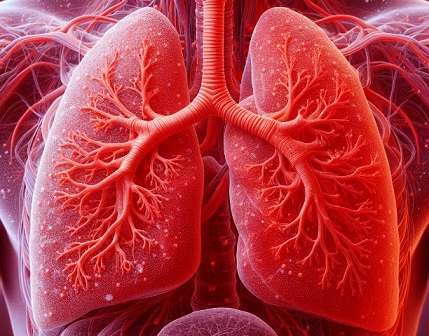67.9 Percent of Patients Who Had Severe COVID-19 Pneumonia Have Evidence of Fibrosis Three Months After Discharge
Nikhil Prasad Fact checked by:Thailand Medical News Team Dec 14, 2024 4 months, 1 week, 5 days, 6 hours, 55 minutes ago
Medical News: The Impact of COVID-19 Beyond Recovery
The COVID-19 pandemic has not only brought a wave of acute illnesses but also a range of persistent health challenges. One of the most concerning long-term effects is post-COVID pulmonary fibrosis - a condition where scarring in the lungs can impair respiratory function. Researchers from the University of Medicine and Pharmacy Carol Davila and the National Institute for Infectious Diseases Prof. Dr. Matei Bals, both in Bucharest, Romania, conducted a groundbreaking study exploring this issue in patients who experienced severe forms of COVID-19.
 67.9 Percent of Patients Who Had Severe COVID-19 Pneumonia Have
67.9 Percent of Patients Who Had Severe COVID-19 Pneumonia Have
Evidence of Fibrosis Three Months After Discharge
The study examined 420 patients across three pandemic waves, analyzing lung fibrosis three months after hospital discharge and again two years later. This
Medical News report highlights the study's findings and implications for the future of post-COVID care.
What is Pulmonary Fibrosis?
Pulmonary fibrosis occurs when lung tissue becomes damaged and scarred, making it difficult for oxygen to pass into the bloodstream. This condition can develop as a consequence of severe pneumonia, acute respiratory distress syndrome (ARDS), and prolonged mechanical ventilation, all of which were commonly observed in severe COVID-19 cases. In the study, researchers found that 67.9% of patients had evidence of fibrosis three months after discharge, although this dropped to 42.4% after two years, reflecting some recovery over time.
Key Findings of the Study
The research revealed crucial insights into how lung fibrosis evolves over time:
-Reduction in Fibrosis: Severity At the three-month evaluation, 11.6% of patients exhibited severe fibrosis. By the two-year mark, none of the cases fell into the severe category. Instead, there was a rise in cases of mild fibrosis, indicating partial reversibility of the condition over time.
-Patterns of Fibrosis: Initially, the most common fibrosis pattern was ground-glass opacity, found in 61.9% of patients. By the two-year evaluation, linear and reticular patterns became predominant, affecting 39.7% of patients. These patterns reflect changes in how scar tissue forms and organizes within the lungs.
Risk Factors Identified
The study identified several factors that increased the likelihood of developing fibrosis:
-Inflammatory markers: Elevated levels of erythrocyte sedimentation rate (ESR), fibrinogen, and D-dimers were strongly correlated with lung fibrosis.
-
Biochemical markers: High levels of lactate dehydrogenase (LDH) and aspartate aminotransferase (AST) were also significant predictors.
-Age and hospital stay: Older age and
prolonged hospitalization were linked to higher risks of fibrosis.
Prognostic Models Developed
Using statistical modeling, the researchers created predictive tools to estimate fibrosis risk at three months and two years. Interstitial pulmonary involvement emerged as the strongest predictor, with specific thresholds correlating with fibrosis severity.
Insights into Recovery Trends
A particularly encouraging finding was the significant decrease in fibrosis cases over time. Nearly 37.5% of patients who had fibrosis at three months showed complete regression by the two-year follow-up. The researchers emphasized that early and sustained medical intervention could play a role in mitigating long-term lung damage.
Mechanisms Behind Post-COVID Fibrosis
Fibrosis results from a complex interplay of inflammatory, immunological, and mechanical factors:
-Hypoxemia-induced pathways: COVID-19’s impact on oxygen exchange can trigger cellular pathways that promote scarring.
-Macrophage activation: The immune system’s response to the virus involves macrophages, which can stimulate fibroblast activity and collagen deposition.
-Direct viral effects: SARS-CoV-2 has been shown to interact with lung fibroblasts, encouraging them to form scar tissue.
Clinical Implications and Recommendations
The study’s findings underline the importance of follow-up care for patients who recover from severe COVID-19. Regular imaging, such as CT scans, can help monitor lung health and detect fibrosis early. For patients at high risk, anti-inflammatory and anti-fibrotic therapies may offer potential benefits.
Moreover, the extent of interstitial pulmonary involvement - a measure of how much lung tissue is affected - proved to be a valuable tool for predicting fibrosis. Clinicians can use this metric to identify patients who may benefit from more aggressive follow-up and treatment strategies.
Concluding Thoughts
Post-COVID pulmonary fibrosis represents a significant challenge for global health, affecting nearly half of all patients with severe pneumonia two years after their initial illness. However, the findings of this study offer hope. The reduction in fibrosis severity over time suggests that the condition is not entirely irreversible, and medical interventions may enhance recovery prospects.
The study findings were published in the peer-reviewed journal: Diagnostics.
https://www.mdpi.com/2075-4418/14/24/2811
For the latest COVID-19 News, keep on logging to Thailand
Medical News.
Read Also:
https://www.thailandmedical.news/news/breaking-covid-19-news-44-9-percent-of-post-covid-individuals-develop-lung-fibrosis-irrespective-of-asymptomatic-or-mild-infections-jn-1-is-worse
https://www.thailandmedical.news/news/long-term-lung-healing-even-after-mild-or-moderate-covid-19-many-could-develop-lung-fibrosis
https://www.thailandmedical.news/news/breaking-silent-tsunami-of-post-covid-lung-fibrosis-occurring-among-many-indian-researchers-warn-that-even-asymptomatics-are-at-risk
https://www.thailandmedical.news/news/long-covid-news-stanford-study-shows-that-innate-immune-cell-activation-causes-lung-fibrosis-that-can-lead-to-long-covid-breathing-problems
https://www.thailandmedical.news/news/breaking-covid-19-news-wisconsin-study-shows-that-sars-cov-2-causes-cardiac-fibrosis-many-could-die-suddenly
https://www.thailandmedical.news/news/great-news-most-post-covid-individuals-will-develop-lung-issues-similar-to-idiopathic-pulmonary-fibrosis-ipf-with-potential-serious-outcomes
https://www.thailandmedical.news/news/covid-19-linked-to-dangerous-lung-scarring-through-mast-cell-activation
https://www.thailandmedical.news/news/covid-19-is-not-mild-as-most-will-develop-lung-fibrosis-10-percent-of-all-lung-transplants-in-u-s-now-go-to-post-covid-patients
https://www.thailandmedical.news/news/individuals-who-had-covid-19-without-pneumonia-at-higher-risk-for-pulmonary-fibrosis-than-those-with-pneumonia
https://www.thailandmedical.news/news/covid-19-can-lead-to-heart-fibrosis
https://www.thailandmedical.news/news/the-uniqueness-of-post-covid-lung-fibrosis-the-increased-expression-of-atp12a-protein
https://www.thailandmedical.news/news/covid-19-causes-vascular-fibrosis-and-vascular-remodelling
https://www.thailandmedical.news/news/sars-cov-2-causes-ace2-downregulation-and-unique-fibrosis-that-contribute-to-long-covid-19
https://www.thailandmedical.news/news/breaking-doctor-from-uc-san-diego-warns-of-new-covid-19-manifestations-such-as-dermatomyositis-muscular-pains-and-alerts-about-lung-fibrosis
https://www.thailandmedical.news/news/44-4-percent-of-indians-exposed-to-sars-cov-2-suffer-from-post-covid-lung-damage
https://www.thailandmedical.news/news/covid-19-news-sars-cov-2-spike-protein-causes-and-accelerates-systemic-sclerosis-by-upregulating-inflammatory-cytokines,-th17-cells-and-fibrosis
https://www.thailandmedical.news/news/covid-19-news-sars-cov-2-triggers-epidermal-growth-factor-receptor-signaling-pathway,-leading-to-lung-fibrosis-and-lung-cancer-erlotinib-helps
https://www.thailandmedical.news/news/ucla-study-finds-that-covid-19-infections-drives-endothelial-cell-like-myofibroblasts-towards-actual-myofibroblasts-causing-pulmonary-fibrosis
https://www.thailandmedical.news/news/breaking-news-german-study-find-that-30-percent-of-individuals-with-long-covid-have-non-ischemic-myocardial-fibrosis
https://www.thailandmedical.news/news/unraveling-the-enigma-of-post-covid-lung-fibrosis-maladaptive-signals-drive-fibroproliferation,-cedars-sinai-researchers-reveal
https://www.thailandmedical.news/news/university-of-virginia-study-finds-that-sars-cov-2-infections-triggers-reduction-in-circulating-monocytes-that-leads-to-persistent-post-covid-pulmonar
https://www.thailandmedical.news/news/irrespective-of-severity-40-percent-of-post-covid-pneumonia-patients-still-have-impaired-lung-diffusion-and-22-percent-developed-lung-fibrosis-a-year-
https://www.thailandmedical.news/news/breaking-covid-19-latest-sars-cov-2-induces-immunoparalysis-of-human-host,-infects-monocytes,-macrophages-and-can-cause-fibrosis-in-post-covid-19
